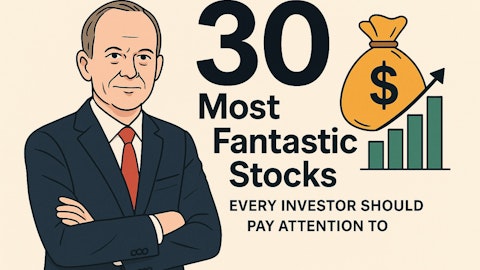In this article, we are going to discuss the 10 best renewable energy dividend stocks to buy now.
With the energy sector being the top source of global emissions, renewables are the need of the hour. Fortunately, the sector continues to make significant strides, and according to the latest figures from the energy think tank Ember, renewables reached a new milestone by overtaking coal as the top source of global electricity in the first half of 2025. Moreover, according to a recent report by the International Energy Agency, the global renewable energy capacity is expected to double over the next five years, increasing by 4,600 GW.
The rapid progress of the clean energy sector is also reflected by the S&P Global Clean Energy Transition Index, which measures the performance of companies in global clean energy-related businesses from both developed and emerging markets. The index has surged by more than 45% since the beginning of the year, compared to gains of just under 15% by the S&P 500.
With that said, here are the Best Dividend Stocks in the Renewable Energy Sector.

Our Methodology
To collect data for this article, we observed various companies operating in the renewable energy sector and then shortlisted the ones with annual dividend yields of over 2.5% as of November 14, 2025. While some of these names are not pure-play clean energy companies, they have made significant investments in the renewables sector. The following are the Best Clean Energy Dividend Stocks to Buy Now.
Why are we interested in the stocks that hedge funds pile into? The reason is simple: our research has shown that we can outperform the market by imitating the top stock picks of the best hedge funds. Our quarterly newsletter’s strategy selects 14 small-cap and large-cap stocks every quarter and has returned 427.7% since May 2014, beating its benchmark by 264 percentage points (see more details here).
10. NextEra Energy, Inc. (NYSE:NEE)
Dividend Yield as of November 14: 2.7%
With a market cap of over $175 billion as of the writing of this article, NextEra Energy, Inc. (NYSE:NEE) is the most valuable utility company in the world. The company boasts a diverse mix of energy sources, including natural gas, nuclear, renewable energy, and battery storage.
NextEra Energy, Inc. (NYSE:NEE) has grown its dividend every year since 1994, including a 10% increase in February 2025. The company intends to continue this momentum and expects to raise its dividends per share at roughly 10% per year through at least 2026 off a 2024 base.
To make sure it can sustain such a high level of payouts, NextEra Energy, Inc. (NYSE:NEE) remains focused on expansion. A Bloomberg report revealed on November 7 that the company is nearing a deal to acquire the gas retail platform Symmetry Energy Solutions for around $800 million. The deal, which marks an important step for NextEra to keep up with the ballooning energy demand, could be announced within weeks.
NextEra Energy, Inc. (NYSE:NEE) also remains an important player in the clean energy space and boasts a national footprint with nearly 30 gigawatts in renewables and storage backlog.
9. The Southern Company (NYSE:SO)
Dividend Yield as of November 14: 3.26%
The Southern Company (NYSE:SO) is one of the largest producers of electricity in the United States and the largest wholesale provider in the Southeast. Together with its subsidiaries, the company delivers clean, safe, reliable, and affordable energy to its 9 million customers.
The Southern Company (NYSE:SO) received a blow on November 6 when Goldman Sachs downgraded the stock from ‘Buy’ to ‘Neutral’, while also reducing its price target from $106 to $98. The analyst believes that the recent Georgia Public Service Commission election, in which two Democrats unseated two Republican incumbents, has limited the stock’s valuation upside due to the increased uncertainty ‘in a historically solid and certain regulatory jurisdiction’.
Earlier on November 5, Jefferies also downgraded The Southern Company (NYSE:SO) from ‘Buy’ to ‘Hold’, while cutting its price target from $114 to $103, stating that the Republican losses in the aforementioned election have materially increased the stock’s risk profile.
The Southern Company (NYSE:SO) reported mixed results for its third quarter on October 30, with the company’s revenue of $7.82 billion falling short of estimates by $100 million, despite a 7.5% YoY increase. However, SO still managed to beat its quarterly profit estimates on the back of the surging demand for electricity from businesses. The company also declared a quarterly dividend of $0.74 per share on October 20.
8. Consolidated Edison, Inc. (NYSE:ED)
Dividend Yield as of November 14: 3.41%
Consolidated Edison, Inc. (NYSE:ED) operates one of the largest energy delivery systems in the world, providing electric, gas, and steam service to the 10 million people living in New York City and Westchester County. The company sources electricity from all over New York, whether it’s from solar, wind, or generating stations.
On November 10, Barclays lowered its price target on Consolidated Edison, Inc. (NYSE:ED) from $105 to $101, while maintaining its ‘Underweight’ rating on the stock following the company’s third-quarter report.
That said, Consolidated Edison, Inc. (NYSE:ED) reported impressive results for its Q3 on November 6, with the utility beating forecasts in both profits and revenue. The company’s net income for the quarter came in at $688 million or $1.91 a share, compared with $588 million or $1.70 per share in the same quarter last year. Meanwhile, net income for the first nine months of FY 2025 was $1.726 billion, up from $1.510 billion in the first nine months of 2024. The growth was primarily due to a higher electric and gas rate base and increased incomes from asset management arrangements and allowance for funds used during construction.
Consolidated Edison, Inc. (NYSE:ED) reaffirmed its optimism by narrowing down its FY 2025 adjusted EPS forecast to be in the range of $5.60 to $5.70 per share, from $5.50 to $5.70 per share previously. Moreover, the company remains focused on strategically investing in its infrastructure, with plans to complete construction of 14 new substations, along with substation upgrades, transmission lines, and storm resiliency measures by 2030.
7. Duke Energy Corporation (NYSE:DUK)
Dividend Yield as of November 14: 3.47%
Duke Energy Corporation (NYSE:DUK) engages in the distribution of natural gas and energy-related services. The company owns and operates a diverse mix of regulated power plants – including hydro, coal, nuclear, natural gas, solar, and battery storage.
On November 10, BMO Capital analyst James Thalacker lowered the firm’s price target on Duke Energy Corporation (NYSE:DUK) from $138 to $136, but maintained an ‘Outperform’ rating on the company’s shares following its recent Q3 results. According to the analyst, the utility’s management is expecting to announce a refreshed 5-year capital plan in the range of $95 billion and $105 billion with Q4 results. The investment plan will drive earnings base growth of more than 8.5% through 2030, with incremental equity funding 30% to 50% of higher CapEx.
Duke Energy Corporation (NYSE:DUK) reported strong results for its third quarter on November 7, with the company topping revenue and profit estimates on the back of a strong power demand and higher electricity rates.
Duke Energy Corporation (NYSE:DUK) boasts an attractive annual dividend yield of 3.47% as of the writing of this piece, putting it among the 12 Best Utility Stocks to Buy for Dividends.
6. Brookfield Renewable Corporation (NYSE:BEPC)
Dividend Yield as of November 14: 3.53%
Brookfield Renewable Corporation (NYSE:BEPC) operates one of the world’s largest publicly traded platforms for renewable power and decarbonization solutions. The company’s diversified portfolio consists of hydroelectric, wind, solar, distributed energy, and sustainable solutions across five continents.
Brookfield Renewable Corporation (NYSE:BEPC) hit a multi-year high last week, despite the company posting lower-than-expected results for its Q3 on November 5. However, Brookfield reported FFO of $302 million during the quarter, up 10% YoY, driven by significant growth in its hydroelectric and wind, and solar segments. The company also committed or deployed up to $1.2 billion across multiple investments in key markets, including closing its recent incremental investment in Isagen.
Brookfield Renewable Corporation (NYSE:BEPC) also announced a quarterly dividend of $0.373 per share and boasts an impressive annual dividend yield of 3.53%. The company is forecasting more than 10% annual FFO per share growth, with a target to raise its cash distributions by 5% to 9% annually.
As of the writing of this piece, the share price of Brookfield Renewable Corporation (NYSE:BEPC) has gained by almost 50% since the beginning of 2025.
5. Eversource Energy (NYSE:ES)
Dividend Yield as of November 14: 4.11%
Next on our list of the Best Clean Energy Dividend Stocks to Buy Now is Eversource Energy (NYSE:ES), which operates New England’s largest energy delivery system and serves customers in Connecticut, Massachusetts, and New Hampshire.
Eversource Energy (NYSE:ES) received a lift on November 10 when Goldman Sachs analyst Carly Davenport raised the stock’s price target from $79 to $80, while maintaining a ‘Buy’ rating on its shares.
Eversource Energy (NYSE:ES) reported strong results for its third quarter on November 4, beating estimates in both profits and revenue, helped by higher rates for its services. The company reported earnings of $367.5 million during Q3, compared to a loss of $118.1 million in the same period last year. Eversource’s revenue also grew by over 5% YoY to $3.22 billion.
Eversource Energy (NYSE:ES) remains focused on growth and reaffirmed its 5-year capital plan of $24.2 billion through 2029. Moreover, the company narrowed its adjusted profit forecast for FY 2025 to $4.72 to $4.80 per share, compared to its original guidance range of $4.67 to $4.82 per share. It also expects its EPS compound growth rate within the range of 5% to 7% from a 2024 base of $4.57 per share.
4. Dominion Energy, Inc. (NYSE:D)
Dividend Yield as of November 14: 4.41%
Dominion Energy, Inc. (NYSE:D) provides regulated electricity service to 3.6 million homes and businesses in Virginia, North Carolina, and South Carolina, and regulated natural gas service to 500,000 customers in South Carolina. The company currently owns or contracts with renewable projects totaling more than 2.5 GW of capacity across five different states.
Following Dominion Energy, Inc. (NYSE:D)’s recent Q3 results, BMO Capital analyst James Thalacker lowered the stock’s price target from $67 to $65 earlier this month, but maintained a ‘Market Perform’ rating on the company’s shares. The analyst highlighted Dominion topping consensus in the quarter, helped by increased power demand in its Virginia and South Carolina segments.
Moreover, Dominion Energy, Inc. (NYSE:D) narrowed its 2025 operating earnings guidance to $3.33 – $3.48 per share, from $3.28 -$3.52 per share previously. It also reaffirmed its long-term EPS growth CAGR of 5% – 7%, anchored off the 2025 midpoint ex 45Z credits of $3.30. According to the analyst, the utility has also started to lay the groundwork for the drivers of what is expected to be a robust capital plan, to be announced on the Q4 call in early 2026. Dominion recently stated that it is in various stages of contracting to provide data centers with 47 GW of capacity, up 17% from around 40 GW as of December 2024.
3. Clearway Energy, Inc. (NYSE:CWEN)
Dividend Yield as of November 14: 5.03%
With a portfolio that comprises approximately 11.8 GW of gross generating capacity in 26 states, Clearway Energy, Inc. (NYSE:CWEN) is one of the largest owners of clean energy generation assets in the United States.
Clearway Energy, Inc. (NYSE:CWEN) received a boost on November 5 when Roth Capital raised its price target on the stock from $38 to $39, while keeping a ‘Buy’ rating on its shares. The update follows an impressive Q3 performance by the company, in which it topped expectations in both earnings and revenue. Clearway’s net income surged to $60 million, more than double compared to last year, helped by lower tax expenses, new investments, and favorable wind patterns.
Clearway Energy, Inc. (NYSE:CWEN) also narrowed its FY 2025 CAFD (Cash Available For Distribution) guidance to a range of $420 million to $440 million, while also introducing a higher-than-expected 2026 guidance of $470 million to $510 million. Moreover, the company’s management confirmed its commitment to a long-term annual growth target of 5% to 8% or higher.
Clearway Energy, Inc. (NYSE:CWEN)’s growth in net income allowed it to increase its dividend by 1.62% to $0.4528 per share, giving the company an annual dividend yield of 5.03% as of the writing of this piece.
2. The AES Corporation (NYSE:AES)
Dividend Yield as of November 14: 5.09%
The AES Corporation (NYSE:AES), together with its subsidiaries, operates as a power generation and utility company in the United States and internationally. Ranked as the largest global supplier of clean energy to corporations by BloombergNEF for the third consecutive year, the company maintains a substantial project pipeline across solar, wind, and energy storage.
On November 6, Mizuho raised its price target on The AES Corporation (NYSE:AES) from $15 to $16, while keeping an ‘Outperform’ rating on its shares. This target represents an upside potential of over 15% from the stock’s current share price, as of the writing of this piece.
The AES Corporation (NYSE:AES) reported mixed results for its Q3 on November 4, with its adjusted EPS of $0.75 falling just below expectations by $0.02. However, the company’s revenue of $3.35 billion managed to top estimates by over $126 million. AES also remains on track to sign 4 GW of new PPAs this year, with 2.2 GW already signed and advanced negotiations expected to bring in at least an additional 1.8 GW by year-end. Moreover, it highlighted a 46% growth in YTD renewables EBITDA, driven by organic growth and maturing renewables businesses in the US.
The AES Corporation (NYSE:AES) also remains committed to its shareholders and reaffirmed its commitment to return over $500 million in dividends this year, while also investing approximately $1.8 billion towards new growth.
1. Enbridge Inc. (NYSE:ENB)
Dividend Yield as of November 14: 5.58%
Topping our list of the Best Renewable Energy Dividend Stocks is Enbridge Inc. (NYSE:ENB), a midstream energy operator that focuses on transporting and distributing oil, natural gas, and natural gas liquids. The company has also committed more than $8 billion in capital to renewable energy projects currently in operation or under construction.
Enbridge Inc. (NYSE:ENB) received a boost on November 10 after attracting positive attention from a number of analysts. RBC Capital analyst Maurice Choy raised the stock’s price target from C$67 to C$72, while maintaining an ‘Outperform’ rating on its shares. Moreover, National Bank analyst Patrick Kenny also raised the firm’s price target on ENB from C$65 to C$66, while keeping a ‘Sector Perform’ rating on its shares. Finally, BMO Capital also raised its price target on Enbridge Inc. (NYSE:ENB) from C$66 to C$67 and kept a ‘Market Perform’ rating on the shares.
That said, Enbridge Inc. (NYSE:ENB) reported mixed results for its third quarter recently, with its adjusted EPS of $0.33 falling short of estimates by $0.04. However, the company’s revenue of $10.43 billion managed to exceed expectations by a significant $2 billion. Enbridge also announced a quarterly dividend of C$0.9425 per share.
Gregory Abel, President and CEO of Enbridge Inc. (NYSE:ENB), stated the following regarding the company’s renewables segment in the Q3 earnings call:
“Renewable projects have been a great place to invest in the last few years, driven by strong PPA prices, decreasing supply costs, and the associated tax benefits. The four projects on this slide showcase over 2 gigawatts of power backed by agreements with some of the largest technology and data center players in the world, including Amazon and Meta. Fox Squirrel and Orange Grove are currently operational. Sequoia Solar will fully enter service in 2026 and Clear Fork will follow entering service in 2027. Looking ahead, we still have a number of projects in the queue that we’re advancing. But as always, we’ll remain opportunistic and continue to stand by our strict investment criteria.”
While we acknowledge the potential of ENB to grow, our conviction lies in the belief that some AI stocks hold greater promise for delivering higher returns and have limited downside risk. If you are looking for an AI stock that is more promising than ENB and that has 100x upside potential, check out our report about this cheapest AI stock.
READ NEXT: 12 Best Utility Stocks to Buy for Dividends and 11 Best High Yield Energy Stocks to Buy Now.
Disclosure: None. Insider Monkey focuses on uncovering the best investment ideas of hedge funds and insiders. Please subscribe to our free daily e-newsletter to get the latest investment ideas from hedge funds’ investor letters by entering your email address below.





